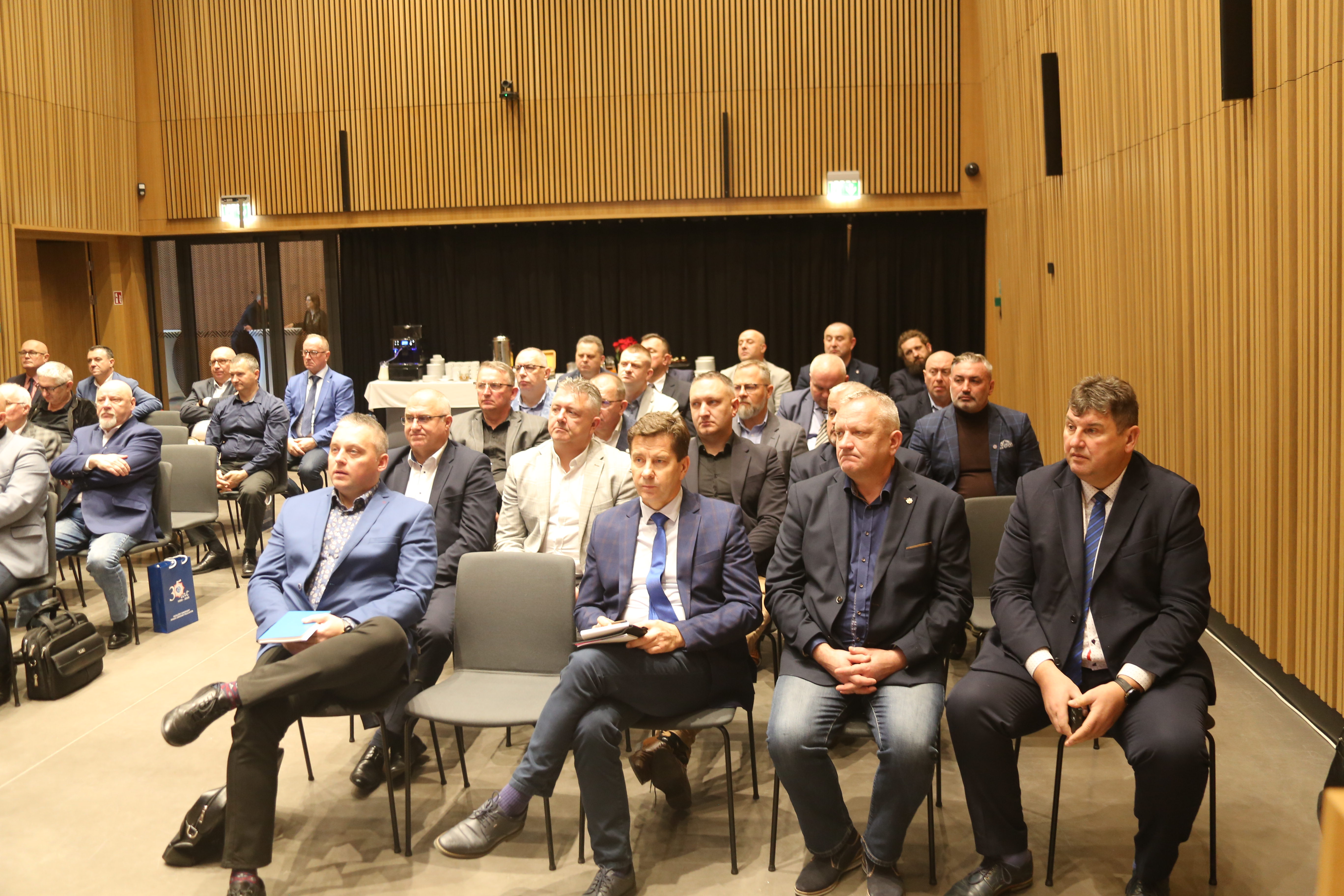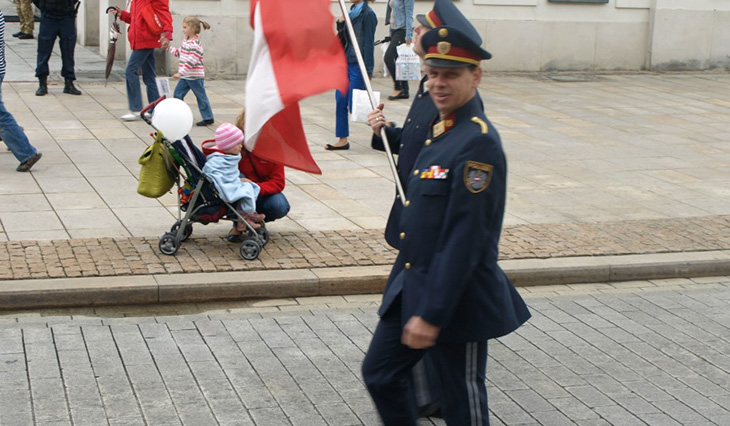
On the example of the Russian Federation
Last article by my colleague Darius Kosiur (‘Ah, this “collective Putin” – all causes problems), He provoked me to include this text.
Anyone who has had the chance to get to know Dark's publicist can rapidly identify her after any of the phrases that are characteristic of him. The concept of capitalism is clarified by the word “Jewish-capitalism”, the concept of Christianity is formatted to describe “Jewish-Catholicism”, and mainstream global media are referred to as “Jewish-media”.
I have known the publication of my colleague for more than 15 years (and even for this reason we have suffered both the "legal" consequences – now at the level of the cassation complaint issued by the "independent courts" in Poland in relation to Dark and me, as a consequence of the study of a Zionist organization – from the stables "Michnik and friends" – under the mocking of Poles the name: "Open Republic") and I know that he always referred with the reserve and very critically to the alleged statistical data, especially the fact of announcing certain "statistical data" in those, as Darek defines, "Jewish-media", which he has counted for years and most likely inactive includes (?) Radio TOK FM.
Knowing that – as I thought alternatively well Dark's views on many socio-economic issues, and having in head many earlier issues His statements, how amazed I was that he abruptly cites, as a reliable origin and argument in the discussion, the data of the "Jewish-Media", which in turn mention to the "Jewish-statistician" in the "Jewish propaganda space" in Russia?!
Yes, dear Dark, as you know, and even from time to time you admit it (although little recently?) besides in Russia judaic influences, or possibly a more precise Zionist lobby, in various spheres of Russian state life, are very significant. And not only Poland, the US and the full “Jewish-West” is plagued by “a deadly illness carried by financial and political media and now besides by pharmaceutical and nutrition” (this is simply a paraphrase of the title known years ago by Krzysztof Zanussi, directed by Krzysztof Zanussi, entitled “Life as a deadly sexually transmitted disease”. Russia is besides attacked by this deadly disease. And I will remind you that for 25 years it has been Russia under the supposedly sovereign, decisive – sovereign and far-reaching regulation of Vladimir Putin.
PZ
——————
And now, after this somewhat extended introduction, I decision on to the meritum, or the thesis of the Dark, that: Russia -, its economy and society, despite the war in Ukraine, the policy of sanctions of the West, - develops dynamically and notes economical growth, which should envy not only Poland, but the full Western planet - "Jewish-capitalism".
It is simply a large way to explain what Russian publications are about, due to the fact that I think it is best to mention to Russian sources and authors there if you want to justice Russian matters.
Valentin Katasonov. GDP in the GDP age: Rosstat juggles numbers well, but he's not the only one.
Financers, traders and 2.4 million officials take first place in creating public goods
Each country's economy is reflected in national accounts statistics, mainly gross home product (GDP). The GDP structure is presented in 3 main sections: by production, by usage and kind of income. late Rosstat posted on his website the latest statistic on Russian Federation GDP for 2023. It is worth considering, assessing the structure of the Russian economy, and besides seeing the directions of changes to this structure.
The subject is very broad. Therefore, I will now focus solely on the analysis of the structure of GDP by production. This structure gives an thought of the contribution of individual sectors and industries to the creation of gross added value, i.e. the GDP of the Russian Federation. Rosstat's website contains statistic on the structure of GDP production since 2002. This way we can measure trends over more than 2 decades.
Everyone knows that the russian Union was an industrial country, as manufacture (production and processing) has made a major contribution to the emergence of social product (at the time, gross social product and national income indicators were utilized to measurement social product) of economical activity; there was no GDP ratio).
For example, in 1975 the share of manufacture in the creation of gross social product (PSB) of the russian Union was 64.7% according to the Central Statistical Office of the USSR. For comparison, the shares of another sectors in the year indicated (%): agriculture – 14,2; construction – 10.6; transport and communications – 4.3; trade, supply, logistics and another sectors – 6.2. There seems to be no uncertainty that this country was industrial. The structure of the PSB was about the same in the 1980s.
Now let's decision rapidly to the russian era. According to Rosstat data, in 2002, the share of manufacture in the GDP creation of the Russian Federation was 23.9%, with the share of the extractive manufacture 6.7% and the processing manufacture 17.2%.
There is simply a concept of "real economy" or "real economy". This real economy, in addition to industry, besides covers a number of sectors. These sectors and their contribution to GDP creation in 2002 (%): agriculture and fisheries – 6.3; electricity, gas and water generation and distribution – 3.6; construction – 5.4.
Transport and connectivity are partially included in the real economy. In 2002, the sector accounted for 10.2%. Let us presume that half of this indicator (i.e. 5.2%) can be attributed to the real economy. In conclusion, we find that the contribution of the real economy to the GDP creation of the Russian Federation in 2002 was 44.4%.
According to the russian statistical accounting methodology, most of the another industries and spheres of public life were not active in creating the social product, but were its consumers. We are talking about trade, financial institutions, wellness care, education, etc. This methodological approach was in line with the strategical guidelines of the russian State, which considered the creation and strengthening of the material and method base of society a priority.
During the russian period, specified a task disappeared, which began to weaken and even destruct the country's material and method base. Not only industry, but all another sectors of the real economy have fallen into collapse. The commercialization of all areas of activity began and a false view began to make that everything that sells or otherwise creates money is simply a useful activity that increases social wealth (GDP).
In fact, social wealth is created by the real sector and another sectors and industries simply redistribute and/or consume this social wealth. This fraud is explained and justified in the economical textbooks written by Soros grants. This fraud is reflected in Rosstat's methodology, which confuses both production and consumption of public products. Thus, artificial inflation of the GDP bubble.
Of course, Rosstat did not invent specified a statistical “chemistry”. Just in the early '90s. Russia was drawn into the "civilised world", and it was immediately imposed on Russia a fresh methodology of national accounts statistics. The West has long been engaged in pumping statistical “baniek” and cheating society.
New statistic were supported by a fresh ideology. They say that the "industrial economy" is simply a relic of the past. It is replaced by a post-industrial society. The second is based primarily on the creation and consumption of various "services". Since the late 1960s, humanity has been bombarded with the word “post-industrial society” as the perfect of a “new wonderful world”.
The word was coined by Zbigniew Brzeziński in his book "Technotronic Era". Both Gorbachev and Jelcin were very worried that Russia was falling behind the "civilized" West in terms of the rate of entry into post-industrial society. In early 2005, the Gorbachev Foundation published a study "Pierestroika: 20 years later". At the beginning of this study we read: "The world's most developed countries have already entered the post-industrial era, while the russian Union has remained at the erstwhile industrial phase of development".
“Democratic” Russia began to rapidly overcome the noticeable “delay”. Now the state is simply no longer carrying out the functions and duties assigned to it by the Constitution, but "provides services". Now a government authoritative does not serve, but "provides services". A soldier not only defends the homeland, but "provides services". The doctor and caregiver do not supply care to patients, they “provide services”. Ittp.
In countries where public houses are legalised (which is now the majority of countries in the West), prostitutes are active in socially useful activities, making a real contribution to GDP growth. In countries where drugs are legalized, producers and herb traders besides increase GDP.
These sectors, which in the russian macroeconomic statistic methodology were part of the sphere of redistribution of social product, now, as it turns out, form it. These include wholesale and retail trade, financial services, etc. They besides “provide services.”
Of course, in the early 21st century Russia continued to fall behind the "economically developed" Western countries in the pursuit of a post-industrial society. In 2002, real sector accounted for 44.4% of GDP, as I mentioned above. And everything else that Brzeziński said should be attributed to the post-industrial society is 55.6%.
But in the US, they had the following GDP structure (%): manufacture (processing and mining) – 20; agriculture – 2; post-industrial branches – 80.
In this century, Russia has tried to minimize the distance to the West in terms of the degree of deindustrialisation. And in that she achieved considerable success. I'll give you the latest Rosstat data for 2023. These are the shares of real economy sectors in GDP creation (%): mining manufacture – 12,4; processing manufacture – 13,5; agriculture and fisheries – 4,0; electricity, gas and water generation and distribution – 2,2; construction – 5.0.
I have already pointed out that transport and communications are partially included in the real economy. In 2023, the sector represented 6.9%. About half of this figure is attributed to the real economy – 3.5%.
Overall, the real economy represented 40.6%, including the full manufacture (mining and industrial processing) – 25.9%. Post-industrial sectors accounted for 59.4%. advancement towards a post-industrial society from 2002 to 1923. There it is. Although traffic takes very tiny steps.
For example, in 2022 the share of the mining manufacture was 13.7% and the processing manufacture was 13.9%. The yearly decrease in indicators was 1.3 and 0.4 percent points respectively.
Probably the faster deindustrialization of Russia was interrupted by a peculiar military operation (SOW) in Ukraine. Whether we like it or not, we request to increase military production.
I would besides like to point out that in the processing industry, the industries active in the production of machinery, equipment and another equipment and their repair accounted for only 3.3% of GDP.
Those who dream of a completely post-industrial Russia could not neglect to enjoy specified activities as wholesale and retail trade. Between 2022 and 2023, the share of this sector increased from 13.0 to 13.4%. Trade in terms of its contribution to GDP is almost equal to the full production industry!
Other sectors that helped Russia get closer to the post-industrial state: the provision of financial services (increase from 4.0 to 5.2%); administrative activities (from 2.2 to 2.3%), IT activities (from 2.9 to 3.2%). But a major breakthrough was made by the "Public Administration and Military Security" sector.
His yearly share increased from 7.1 to 7.8%. In our country, therefore, government officials and military officials are straight contributing to GDP growth. Where possible, their contribution shall be assessed utilizing the remuneration method. The sum of their salaries represents an increase in the country's GDP.
In the USSR, the number of officials was estimated to be 2.3 million. In the Russian Federation, where the population is about half the size of the russian Union, the army of officials of all levels at the beginning of the 21st century had a population of 3.45 million people.
Despite many “optimization” of state administration apparatus, according to the Ministry of Finance, in early 2022 the army of officials had 2.4 million people.
Not logical. If officials are active in the creation of GDP, their army should not be reduced but increased. And if the military besides contributes to creating added value in Russia, we should increase the number of armed forces. And get free of prejudice that any war harms the economy.
In general, after reading this, many questions and doubts arise about the creation of Russia's gross home product. There is besides a sneaky doubt: did real GDP increase at the end of 2023? In January we were solemnly informed that last year we ended a evidence GDP growth of 3.6%.
It cannot be excluded that military personnel, as well as persons working in wholesale and retail trade, financial services, administrative activities and public administration, have contributed to this "record". And this "record" secretly covers the ongoing process of deindustrialisation of Russia.
Current GDP statistic can be compared to a broken compass that can yet lead Russia to a swamp.
Written by Valentin J. Katasonov
https://svpressa.ru/economy/article/410984/
Appendix
Rosstat estimated Russia's GDP growth in the first quarter
Rosstat published the first assessment of Russian GDP dynamics in the first 4th of 2024. The Russian economy grew by 5.4%, mainly through wholesale and retail trade and industrial processing
Rosstat presented the first assessment of the dynamics of the Russian economy in the first quarter. According to her, Russia's GDP increased annually by 5.4% after an increase of 4.9% in the 4th fourth of 2023. Its volume in current prices was 43.24 trillion rubles. The GDP deflator index reflecting price developments in the economy increased by 13.4%.
GDP growth has mainly ensured the dynamics of wholesale and retail trade and the processing industry. The increase in turnover in wholesale trade was 11.7%, in retail trade – 10.5%, which is associated with an increase in request for consumer goods, machinery and equipment – Rosstat points out. In industrial processing, value added dynamics amounted to plus 9%, the most noticeable increase occurred in the production of motor vehicles, trailers and semi-trailers (+35.7%), computers, electronic and optical products (+42.4%) and finished products. metallic products (+35.2%). Rosstat besides has affirmative dynamics in construction (+4.8%), which explains the implementation of major investment projects and in the hotel-restaurant sector (+4.6%) – due to the increasing request in the catering market.
The growth of the deflator rate, as Rosstat points out, was mainly influenced by the increase in the prices of energy natural materials, food and non-food products, as well as by the increase in the rates for freight and passenger transport, as reflected in the increase in the industry's deflator indices.
Rosstat's confirmation of Russia's GDP growth estimates of 5.4% suggests that the economy has proven to be much better adapted to external shocks than could be expected, noted Deputy Head of the Ministry of economical improvement Polina Kriuchkowa. She stressed that economical growth has a "frontal character". "The production in key industries, specified as production, trade and IT, has increased. This indicates a diversification of the economy and a simplification in dependence on conventional sectors, in peculiar mining", she said.
As the analysts of the Bank of Russia have already pointed out, 1 of the main drivers of the advanced growth of the Russian economy in the first 4th of this year was the increase in budget expenditure, which in the first 4th was usually ahead of the seasonal schedule. Additional request from the State besides translated into increased request from the private sector, both through production covered by government procurement and through budget transfers and payments to households, the Central Bank explained. The regulator noted that the same processes have stimulated credit operations. As a result, the increase in gross value added in the first 4th was 18.8% in financial and insurance activities. At the same time, Central Bank analysts noted that in April, in the Russian economy, mainly in the service segment, there were individual signs of slowing growth.
for: https://www.forbes.ru/finance/514755-rosstat-oceneil-rost-vvp-rossii-v-i-kvartale
Race for salaries
In the second quarter, the economy continued to drive private demand
Rosstat confirmed the continuation of a fast increase in income, wages and consumption in Russia, as well as a fresh historical unemployment evidence in the second 4th and the first half of 2024. Analysts noted any cooling of consumer activity only at the end of the second quarter. another sectors are presently liable for slowing GDP growth, and little active request can strengthen it by the end of the year.
According to Rosstat, in the second 4th the real money growth accelerated and despite rising inflation amounted to 7.7% versus 7.1% in the first 4th on an yearly basis (Rosstat increased its estimation from 6.4%). Real disposable income (after taxation and compulsory fees) accelerated the increase to 9.6% respectively compared to 6.4%, resulting in an increase of 8.1% in the first half of the year. According to analysts, the Centre for Macroeconomic Analysis and Short-term Forecasts (CMACF), given seasonality, besides markedly accelerated the quarterly dynamics of real disposable income – from 1.9% in the first 4th of 2024 to 2.4% in the second quarter. This is mostly due to premium payments for six months and deferred wage increases in June, says CMACF expert Igor Poliakow.
The Ministry of Economy notes that the biggest contribution to real income growth in the first half of the year was paid by employees (10.1% of the full effect) and income from assets (28.4%).
"Wage growth (nominal – Kommiersant) will stabilise this year at around 20% (inflation in May amounted to 8.3%, and as of 29 June – 9.1%, according to the Ministry of Economy – Kommersant). This is much faster than wages grew in erstwhile years, but not as fast as at the highest point of overheating the economy in 2007–08. In order to avoid a 20% increase in wages causing strong pro-inflationary effects, productivity must increase by at least 15% per year. It's a fantastic height, which is almost impossible. Therefore, with the labour marketplace so overheated, a rigorous monetary policy is inevitable" said analysts of the MMI channel on Telegram.
The leading industries in nominal wage growth (20% or more in May 2024) are finance, construction, processing, IT, car transport, postal services and delivery, personnel selection. Inside (an increase of 17-20%) there is retail, an agri-industrial complex, hotels, gastronomy and rail passenger transport. Outsiders (an increase of about 15%) – education, wellness care, government administration, wholesale trade, research, rail freight transport, real estate, mining. "But the biggest outsiders of the last fewer years are, of course, pensioners (retirements in real terms since October 2023 invariably fall year-to-year)", notes the authors of the MMI channel. "Raising wages at the current rate could cost employers 6-7 trillion rubles. for a year. By comparison, at the end of 2023, the profit taxation paid by the companies amounted to 7.9 trillion rubles, and by raising the income taxation rate from 20% to 25% The Ministry of Finance plans to collect an additional 1.6 trillion rubles in 2025, ” adds analysts of “Hard Numbers”, noting that the profits of companies do not decrease.
Against this background, unemployment has reached another lowest level in past of 2.4% and the gap between labour supply and request remains close to zero. Between June and May 2024, as estimated by CMACF, employment, after excluding seasonality, increased by a further 0.25%.
According to the Ministry of Economy in June 2024, consumer activity was ‘maintained high’. The full real turnover of retail, catering and toll services in June was 5.6% higher than in the erstwhile year (months before 6.6%) and for the first half of the year the full consumption increased by 7.5%. any slowdown in the dynamics of full consumption (without catering) is besides noted in the Administrative Services Centre: given seasonality, the monthly increase in the ratio slowed in June to 0.2% of 0.6% in May and 1.2% in April . Non-food products (cars and electronics pending an increase in the Central Bank's course) pushed up consumption dynamics and consumption of services (especially medical and informational) and food began to decline.
As a result, according to the Ministry of Economy, the yearly GDP growth rate in June slowed to 3% from 4.5% in May 2024. However, they do not print data that take into account calendar and seasonal effects. Alexander Isakov of Bloomberg Economics believes that the estimates of the Ministry of Economy regarding GDP growth in June may prove to be overstated – 1.7% – partially due to the calendar. "Retail trade was the only sector in which activity increased above 2% in June. another sectors have grown more slowly" he notes, explaining the ministry's calculations as a likely optimistic correction of unobserved data in monthly data (on public sector work, investigation and professional activities, etc.) and on net taxation increases. Overall, for the first half of 2024 the department estimated economical growth of 4.7%, which is higher than the updated Central Bank forecast of 3.5–4% per year, which represents the likelihood of a noticeable economical downturn in the second half of the year.
Artem Chugunov
(PL)









